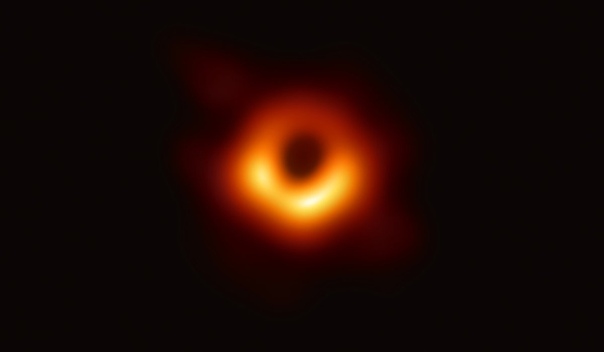Внешний вид сверхмассивной черной дыры был смоделирован несколько лет назад для фильма "Интерстеллар".
Вымышленная черная дыра из фильма "Интерстеллар" скромная по сравнению с центральным объектом М87. Реальная черная дыра, снимком которой мы теперь располагаем, имеет аккреционный диск диаметром 1/3 светового года, вращающийся [видимо, во внешних частях] со скоростью 1000 км/с.
Кольцевое гало вокруг черное дыры - результат "гравитационного линзирования". Проще говоря, гравитационное поле вокруг дыры настолько мощное, что свет выходит на орбиты вокруг нее, а затем покидает их в произвольных направлениях; часть этих направлений, с какой бы стороны от дыры свет не вылетал, направлена на наблюдателя, так что наблюдатель будет видеть вокруг нее светящееся кольцо, где бы он ни находился, с любого ракурса.
Аккреционный диск (диск падающего на не вещества) плоский, и свет от той его части, что скрыта за черной дырой, виден в гало благодаря гравитационному линзированию.
Сверхмощное гравитационное поле порождает и еще один эффект: гравитационное красное смещение. Суть его в том, что чем мощнее притяжение, тем сложнее свету, летящему от гравитирующего объекта к наблюдателю, преодолевать его. Свет всегда распространяется с одной и той же скоростью - 300000 км/с - и воздействие гравитационного поля вкладывается не в саму скорость, а в длину световой волны: чем сильнее свет будет "замедляться", тем больше будет становиться длина его волны (можно сказать, что в том месте, где скорость должна быть снижена до нуля, длина волны станет равна бесконечности). Иными словами, спектр будет смещаться в красную сторону, затем в инфракрасную, затем в радио, и в конце... в бесконечность. Чем ближе к черной дыре точка, с которой луч света вылетает к наблюдателю, тем она будет становиться краснее, затем темнее (по мере ухода из видимой части в инфракрасную), а затем замолкнет насовсем.
Можно видеть, что последний эффект (красное смещение) для модели в "Интерстелларе" не был учтен.
Вымышленная черная дыра из фильма "Интерстеллар" скромная по сравнению с центральным объектом М87. Реальная черная дыра, снимком которой мы теперь располагаем, имеет аккреционный диск диаметром 1/3 светового года, вращающийся [видимо, во внешних частях] со скоростью 1000 км/с.
Кольцевое гало вокруг черное дыры - результат "гравитационного линзирования". Проще говоря, гравитационное поле вокруг дыры настолько мощное, что свет выходит на орбиты вокруг нее, а затем покидает их в произвольных направлениях; часть этих направлений, с какой бы стороны от дыры свет не вылетал, направлена на наблюдателя, так что наблюдатель будет видеть вокруг нее светящееся кольцо, где бы он ни находился, с любого ракурса.
Аккреционный диск (диск падающего на не вещества) плоский, и свет от той его части, что скрыта за черной дырой, виден в гало благодаря гравитационному линзированию.
Сверхмощное гравитационное поле порождает и еще один эффект: гравитационное красное смещение. Суть его в том, что чем мощнее притяжение, тем сложнее свету, летящему от гравитирующего объекта к наблюдателю, преодолевать его. Свет всегда распространяется с одной и той же скоростью - 300000 км/с - и воздействие гравитационного поля вкладывается не в саму скорость, а в длину световой волны: чем сильнее свет будет "замедляться", тем больше будет становиться длина его волны (можно сказать, что в том месте, где скорость должна быть снижена до нуля, длина волны станет равна бесконечности). Иными словами, спектр будет смещаться в красную сторону, затем в инфракрасную, затем в радио, и в конце... в бесконечность. Чем ближе к черной дыре точка, с которой луч света вылетает к наблюдателю, тем она будет становиться краснее, затем темнее (по мере ухода из видимой части в инфракрасную), а затем замолкнет насовсем.
Можно видеть, что последний эффект (красное смещение) для модели в "Интерстелларе" не был учтен.
The appearance of a supermassive black hole was modeled several years ago for the film Interstellar.
The fictional black hole from the movie Interstellar is modest compared to the central object M87. The real black hole, the picture of which we now have, has an accretion disk with a diameter of 1/3 of a light year, rotating [apparently in the outer parts] at a speed of 1000 km / s.
The ring halo around the black hole is the result of "gravitational lensing." Simply put, the gravitational field around the hole is so powerful that light enters orbits around it, and then leaves them in arbitrary directions; a part of these directions, no matter from which side of the hole the light flies, is directed at the observer, so that the observer will see around her a luminous ring, wherever he is, from any angle.
The accretion disk (the disk incident on a non-material) is flat, and the light from the part of it that is hidden behind the black hole is visible in the halo due to gravitational lensing.
The superpower gravitational field generates one more effect: gravitational redshift. Its essence is that the more powerful the attraction, the more difficult the light flying from the gravitating object to the observer, to overcome it. Light always propagates at the same speed — 300,000 km / s — and the effect of the gravitational field is not embedded in the velocity itself, but in the length of the light wave: the stronger the light “decelerates”, the longer its wavelength will become ( that in the place where the speed should be reduced to zero, the wavelength will be equal to infinity). In other words, the spectrum will shift to the red side, then to the infrared, then to the radio, and at the end ... to infinity. The closer to the black hole the point from which the light beam flies to the observer, the more red it becomes, then darker (as it leaves the visible part into the infrared one), and then it stops silently.
It can be seen that the last effect (redshift) for the model in Interstellar was not taken into account.
The fictional black hole from the movie Interstellar is modest compared to the central object M87. The real black hole, the picture of which we now have, has an accretion disk with a diameter of 1/3 of a light year, rotating [apparently in the outer parts] at a speed of 1000 km / s.
The ring halo around the black hole is the result of "gravitational lensing." Simply put, the gravitational field around the hole is so powerful that light enters orbits around it, and then leaves them in arbitrary directions; a part of these directions, no matter from which side of the hole the light flies, is directed at the observer, so that the observer will see around her a luminous ring, wherever he is, from any angle.
The accretion disk (the disk incident on a non-material) is flat, and the light from the part of it that is hidden behind the black hole is visible in the halo due to gravitational lensing.
The superpower gravitational field generates one more effect: gravitational redshift. Its essence is that the more powerful the attraction, the more difficult the light flying from the gravitating object to the observer, to overcome it. Light always propagates at the same speed — 300,000 km / s — and the effect of the gravitational field is not embedded in the velocity itself, but in the length of the light wave: the stronger the light “decelerates”, the longer its wavelength will become ( that in the place where the speed should be reduced to zero, the wavelength will be equal to infinity). In other words, the spectrum will shift to the red side, then to the infrared, then to the radio, and at the end ... to infinity. The closer to the black hole the point from which the light beam flies to the observer, the more red it becomes, then darker (as it leaves the visible part into the infrared one), and then it stops silently.
It can be seen that the last effect (redshift) for the model in Interstellar was not taken into account.


У записи 8 лайков,
0 репостов,
98 просмотров.
0 репостов,
98 просмотров.
Эту запись оставил(а) на своей стене Сара Керриган





























